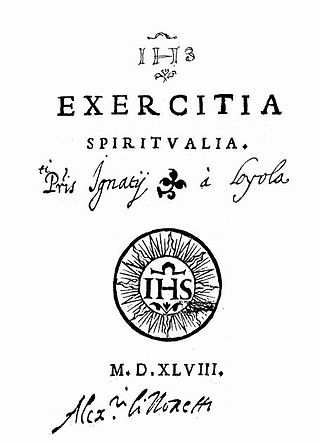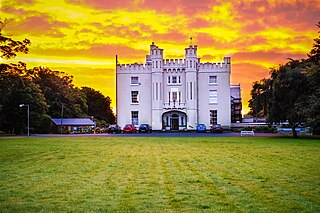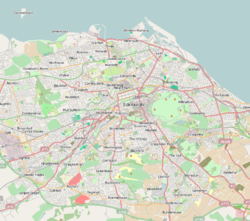
Pedro Arrupe Gondra, SJ was a Spanish Basque priest who served as the 28th Superior General of the Society of Jesus from 1965 to 1983. He has been called a second founder of the Society, as he led the Jesuits in the implementation of the Second Vatican Council, especially with regard to faith that does justice and preferential option for the poor.

The Spiritual Exercises, composed 1522–1524, are a set of Christian meditations, contemplations, and prayers written by Ignatius of Loyola, a 16th-century Spanish priest, theologian, and founder of the Society of Jesus (Jesuits). Divided into four thematic "weeks" of variable length, they are designed to be carried out over a period of 28 to 30 days. They were composed with the intention of helping participants in religious retreats to discern the will of God in their lives, leading to a personal commitment to follow Jesus whatever the cost. Their underlying theology has been found agreeable to other Christian denominations who make use of them and also for addressing problems facing society in the 21st century.

Claude La Colombière, S.J. is a French Jesuit priest and the confessor of Margaret Mary Alacoque. He is venerated as a saint in the Catholic Church.

Joseph Mary Pignatelli, SJ was a Spanish priest who was the unofficial leader of the Jesuits in exile in Sardinia, after the suppression of the Society. Supervising its restoration, he is considered the second founder of the Society of Jesus.

Gordon Dunlap Bennett, S.J. is an African-American former Catholic prelate who served as Bishop of Mandeville in Jamaica from 2004 to 2006. He was banned from returning to active ministry in two dioceses of the Baltimore Province following a sexual harassment allegation.
James Quinn, SJ was a Scottish Jesuit priest, theologian and hymnodist.
Ignatian spirituality, similar in most aspects to, but distinct from Jesuit spirituality, is a Catholic spirituality founded on the experiences of the 16th-century Spanish Saint Ignatius of Loyola, founder of the Jesuit order. The main idea of this form of spirituality comes from Ignatius's Spiritual Exercises, the aim of which is to help one "conquer oneself and to regulate one's life in such a way that no decision is made under the influence of any inordinate attachment." The Exercises are intended to give the person undertaking them a greater degree of freedom from his or her own likes and dislikes, so that their choices are based solely on what they discern God's will is for them. Even in the composition of the exercises by Ignatius early in his career, one might find the apostolic thrust of his spirituality in his contemplation on "The Call of the Earthly King" and in his final contemplation with its focus on finding God in all things.

Sacred Heart, Edinburgh, formally known as the Catholic Church of the Sacred Heart of Jesus, is a Roman Catholic church run by the Society of Jesus, close to the city centre of Edinburgh, Scotland, United Kingdom. It is situated in Lauriston, midway between the Grassmarket and Tollcross, on the edge of Edinburgh’s historic Old Town. The church building was opened in 1860 and is a category A listed building.

Rainhill Hall or Loyola Hall is a Grade II listed country house built in the 19th century in Rainhill, Merseyside, England, by Bartholomew Bretherton. It is situated on the Warrington Road, next to St Bartholomew's Church. From 1923 to 2014, it was a retreat house run by the Society of Jesus. From 2017, it has been a hotel and wedding venue owned by Signature Living.

St Aloysius Church is a Roman Catholic Parish church in the Garnethill area of Glasgow in Scotland. It is the only church in Glasgow to be run by the Society of Jesus. It is situated on the corner of Hill Street and Rose Street and is next door to St Aloysius' College, Glasgow, having a close relationship with the school. When it was built, it was the only Catholic church in Glasgow to have a tower. It is modelled on Namur Cathedral in Belgium and is a Category A listed building.

Campion House was a Roman catholic college run by the Society of Jesus in the Archdiocese of Westminster. It was situated in Osterley on the Thornbury Road, off the A4 road, in the London Borough of Hounslow.
Ignatius Scoles SJ was a Roman Catholic Jesuit priest, architect and writer. He designed churches and civic buildings and was the son of Joseph John Scoles.

Manresa House is a retreat centre run by the Society of Jesus in the Dollymount area of Clontarf in Dublin, near Saint Anne's Park. In the 19th century it was home to Robert Warren and Arthur Guinness, and it is a protected structure.

Sir Leybourne Stanley Patrick Davidson (1894-1981) was a British physician, medical investigator and author who wrote the medical textbook Principles and Practice of Medicine, which was first published in 1952.

St. Ignatius Church is a Roman Catholic Parish church in Notre-Dame-de-Grâce, Montreal West, Quebec. It was founded by the Society of Jesus in 1917 as an English-speaking parish. It is next to Loyola High School and the Loyola Campus of Concordia University.

Manresa Jesuit Spiritual Renewal Centre is a centre for Ignatian spirituality run by the Society of Jesus in Pickering, Ontario. It was founded in 1924 and was built in 1945. It is situated next to Pine Ridge Secondary School just off Finch Avenue in north Pickering.

Parkstead House, formerly known as Manresa House and Bessborough House, is a neo-classical Palladian villa in Roehampton, London, built in the 1760s. The house and remaining grounds are now Whitelands College, part of the University of Roehampton. It is situated on Holybourne Avenue, off Roehampton Lane, next to the Richmond Park Golf Course in the London Borough of Wandsworth. In 1955 it was designated Grade I on the National Heritage List for England.

Loyola House or its full name Loyola House Retreat and Training Centre is a Jesuit spirituality centre in Guelph, Ontario. It moved to Guelph in 1964 and was the centre of a renewal in Ignatian spirituality in the 1970s. It is within the grounds of the Ignatius Jesuit Centre situated on Woolwich Street to the west of Riverside Park. In the 1960s and 1970s it was the centre of a significant shift in Ignatian spirituality.

Jérôme Nadal, SJ was born on 11 August 1507 in Palma De Mallorca, in the Balearic Islands, Spain, and died on 3 April 1580 in Rome. He was a Spanish Jesuit priest in the first generation of the companions of St. Ignatius of Loyola. A very close collaborator of St. Ignatius of Loyola, the founder of the Society of Jesus, he was sent to explain to the various Jesuit communities of Europe the first draft of the Constitutions. He is known as the "Ignatian theologian" for having developed the theology behind Ignatian spirituality.
Juan Antonio Guerrero Alves, S.J., is a Spanish Jesuit priest who served as the prefect of the Vatican's Secretariat for the Economy from 1 January 2020 to 30 November 2022. He previously taught at the university level and held administrative positions within the Jesuit order.


















